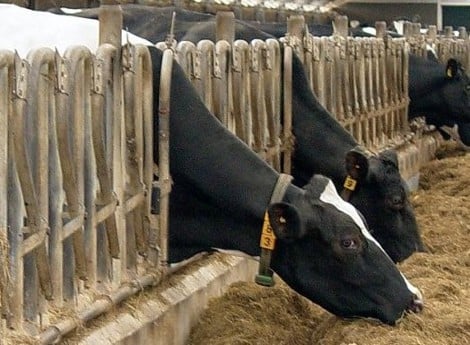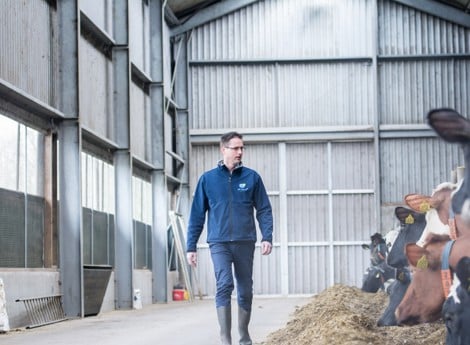Feeding focused on a net profit per cow
Challenging the cows at the beginning of the lactation period improves their health and efficiency, as well as the net profitgain per cow. Of course the milk production response depends on many factors, including the starting ration, the production level and the dry phase. The cows must be able to cope with the increased feed concentrate level.

Challenging the cows at the beginning of the lactation period improves their health and efficiency, as well as the net profit per cow. Traditionally, after calving, the quantity of feed concentrate administered in addition to the basic ration, is built up to the maximum ration (13 kg/cow/day in this research) over a number of weeks.
Go for the challenge
Traditionally, after calving, the quantity of feed concentrate administered in addition to the basic ration, is built up to the maximum ration (13 kg/cow/day in this research) over a number of weeks. After the peak period, depending on the cow's persistence, the feed concentrate ration is once again reduced on the basis of the milk production realised. In recent research conducted by De Heus, a different strategy was tested to further improve the net profit per cow, production efficiency and health. During this research, the cows were brought up to a higher feed concentrate level quicker and were kept at this level for a longer period of time. After ten weeks the feed concentrate ration was adjusted on the basis of the milk production.
More milk, more milk fat and more milk protein
Increasing the maximum feed concentrate in the ration at the beginning of the lactation period for second calf and older cows resulted in 3.8 kilogram higher milk production during the first 155 days of lactation (Figure 1). Among heifers the effect was smaller, because heifers in general have a less severe negative energy balance. Due to the higher milk production, the fat concentration dropped by 0.1 percent, while the milk protein concentration and the lactose concentration stayed the same. The production of kilograms of milk fat, milk protein and lactose per cow per day was significantly higher for the higher feed concentrate ration. What is striking in Figure 1, is that the lines stay parallel. The higher maximum feed concentrate ration at the beginning of the lactation period therefore results in higher milk production throughout the entire lactation period.
Improved health
Despite the considerably higher milk yield during aggressive feeding, the cows had a significantly higher body weight because of a less severe negative energy balance. A less severe negative energy balance correlates with a better start-up and a better functioning immune system of the cows, fewer problems relating to any liver fattening, ketosis, mastitis, fertility or claw problems.
In situations involving low quality roughage or high milk production among heifers, the heifers can also be confronted with a negative energy balance. In such cases, aggressive feeding can also be expected to have an impact on heifers. This therefore depends on the specific farming situation.
Improved net profit
The increased feed concentrate ration resulted in an additional 3.8 kilograms of milk per cow per day. This resulted in an additional yield of 121 grams of milk protein, 63 grams of milk fat and 169 grams of lactose per cow per day (Table 1). This translated into a net increase of € 0.99 in the proceeds per cow per day. The cost of the feed concentrate increased by € 0.70 per cow per day. This resulted in an improved net gain of € 0.29 per cow per day.
Naturally the improvement in the net proceeds depends on the milk selling price and the costs of the feed concentrate. Table 2 shows that higher concentrate levels virtually always pays off and results in a higher net profit per cow. The higher milk yield improved feed efficiency from 1.56 to 1.63 (for an average cow on day 84 of the lactation period) and the phosphate efficiency increased from 42 to 44 percent.

figure 1: Average milk production response of second calf and older cows with higher concentrate levels
Yellow line = higher concentrate level
Grey line = traditional feed concentrate build-up
| Milk protein | Milk fat | Lactose | |
| Additional yield (g) | 121 | 63 | 169 |
| Price (€/kg) | 5,88 | 2,94 | 0,59 |
| Benefit | €0,71 | € 0,19 | € 0,10 |
Table 1: Improvement in milk protein, milk fat and lactose production per cow per day and the associated additional yields during the first 155 days of lactation with higher concentrate levels. (second calf and older cows, RFC prices; guaranteed price of € 0.36/kg of milk)
| Feed price | €0,23 | €0,25 | € 0,28 | €0,30 |
| Milkprice | ||||
| €0,25 | €0,12 | €0,07 | €-0,01 | €-0,06 |
| €0,30 | €0,26 | €0,21 | €0,13 | €0,08 |
| €0,36 | €0,42 | €0,37 | €0,29 | €0,24 |
| €0,40 | €0,53 | €0,48 | €0,40 | €0,35 |
Table 2: Changes in net profit per cow with varying milk and feed prices (€/kg) (for second calf and older cows)
Feasible for everyone?
Of course the milk production response depends on many factors, including the starting ration, the production level and the dry phase. The cows must be able to cope with the increased feed concentrate level. This is why the lactation ration is also subject to criteria pertaining to the structure value and fermentation rate of the carbohydrates at the rumen level. Together with De Heus' cattle specialist determine how you too can increase the bottom line on your farm.






